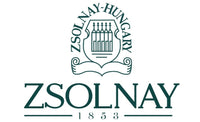A Zsolnay Original
The Eosin Era
In 1893 Vilmos Zsolnay introduced Eosin, a rich, iridescent glazing technique. The term, named after the Greek goddes Eos, goddess of dawn, was used to describe this unique finish.This technique became a trademark of Zsolnay and a favorite of art nouveau artists. The technique is a well-kept secret of the manufacture and its magical appearance has captivated collectors all over the world since it was first presented.
Eosin was developed in the 1890s with the help of Vilmos Zsolnay, together with Lajos Petrik, director of the Budapest Industrial School, and Vince Wartha, professor at the University of Technology.


Innovation & Development
The Secret Formula
In addition to the numerous eosin colors, several manufacturing processes were developed at the Zsolnay factory, for example hand-painted, etched, and marbled Eosins. The manufacture has been producing Eosin since 1893, its iridescent reduction glaze, the secret of its production, being strictly guarded.
Ornaments and building decoration elements are made from this exclusive material. Around the turn of the century, in the spirit of art nouveau, the Eosin technique combined with the new form and decoration was used in the creation of more and more beautiful pieces by world-renowned artists such as Sándor Abt Abt, Lajos Mack, Géza Nikelszky, and József Rippl Rónay.
Iridescent & Unique
The Magic of Eosin
The secret Eosin technique which Vilmos Zsolnay developed creates iridescent metallic colours that are unique to every piece. Each Eosin object is unique and unrepeatable.
The surface of Zsolnay ceramic forms appeared in glossy coatings reminiscent of silk, metal or glass. Those visual effects that transformed depending on the perspective and light made Eosin a captivating new form of expression for artists.
The unique Eosin glaze is a staple of Zsolnay's identity and a favorite among collectors. Stunning Eosin pieces made by Zsolnay can be found in museums across the globe, such as the Metropolitan Museum of Art in New York and the Musée d´Orsay in Paris.

